Addicted to Palm Collecting
last updated February 22
I've written previously about some of my favorite foibles, er ... features so this post about my addiction continues this theme. No, I'm not really an addict (I swear, I can quit anytime I want) but lately I've been buying early Palm Personal Digital Assistant (PDAs) on Ebay (also an addiction) like they were going out of style (and these early ones are). Up 'til now I've never owned nor used a PDA (I'm a cheapskate, remember) so it may seem strange that I would get caught up in this. [I did buy a used Palm M505 about a year ago for a GPS project which hasn't gone anywhere due to my procrastination.]
If you search for Palm PDAs on Ebay you'll find a plethora of models, many very cheap. Though originally these sold for a few hundred dollars, I've gotten them for as little as $1 ($5 shipped). I try to avoid bidding much more than $15 for any one, (shipping should cost $5-$10 or slightly more). My oft exceeded, self-imposed limit was $20, but this limited me to models perceived as of no value. Buyers of these are either beginners, collectors like myself, or well meaning gift-givers who don't know any better.
Early Palm models were powered by AAA batteries, but later and current ones use rechargeable internal Li-ion batteries. The rechargeables are relatively expensive to replace when they wear out, but with advances in low-powered electronics and battery capacity, the time between recharges is now very respectable. There are many accessories and about a bazillion, applications, mostly free, possibly more software than exists for any other device. At one time there were something like 160,000 application developers. The available software cover every possible niche: including ebook readers, general and specialized calculators, maps, GPS, recipe organizers, games, audio/photo/video players, phone, email, word processing, spreadsheets, compilers, etc. Of course older PDAs may not run some of the newer apps. Depending on your needs, one of the more recent PDAs might become your favorite portable device (even replace your ipod).
Old PDAs are still as capable and useful as when they were first made, perhaps even more so now with all the applications and accessories. Just how capable is that? Well lets compare it to the original IBM PC. The original IBM PC had a 4.77 Mhz CPU, the original Palm had a 16 Mhz CPU. The IBM PC came with 16KB to 640KB of RAM, the Palm had 128K to 512KB RAM. The PC had a keyboard and mouse, the Palm had a touchpad with stylus and handwriting recognition. Display? IBM's monochrome resolution: 80 characters x 25 lines, Palm was 160x160 monochrome graphic pixels. But besides being superior to the IBM PC in almost every measure, the battery-powered Palm fit in a shirtpocket, and, well, the IBM PC did/does not, even today. From day one, all Palm models synced (interfaced) with a PC, first via a serial connection, then USB. At some early point infrared was added, and now wireless (bluetooth). The IR feature was one of the few successful uses of this technology, especially for PDA to PDA transfers (Look Ma, no cables). How many of us have (or ever had) any IR devices attached to our home or office computers? Today its main use is in your TV/media remote controls.
If you search for Palm PDAs on Ebay you'll find a plethora of models, many very cheap. Though originally these sold for a few hundred dollars, I've gotten them for as little as $1 ($5 shipped). I try to avoid bidding much more than $15 for any one, (shipping should cost $5-$10 or slightly more). My oft exceeded, self-imposed limit was $20, but this limited me to models perceived as of no value. Buyers of these are either beginners, collectors like myself, or well meaning gift-givers who don't know any better.
Early Palm models were powered by AAA batteries, but later and current ones use rechargeable internal Li-ion batteries. The rechargeables are relatively expensive to replace when they wear out, but with advances in low-powered electronics and battery capacity, the time between recharges is now very respectable. There are many accessories and about a bazillion, applications, mostly free, possibly more software than exists for any other device. At one time there were something like 160,000 application developers. The available software cover every possible niche: including ebook readers, general and specialized calculators, maps, GPS, recipe organizers, games, audio/photo/video players, phone, email, word processing, spreadsheets, compilers, etc. Of course older PDAs may not run some of the newer apps. Depending on your needs, one of the more recent PDAs might become your favorite portable device (even replace your ipod).
Old PDAs are still as capable and useful as when they were first made, perhaps even more so now with all the applications and accessories. Just how capable is that? Well lets compare it to the original IBM PC. The original IBM PC had a 4.77 Mhz CPU, the original Palm had a 16 Mhz CPU. The IBM PC came with 16KB to 640KB of RAM, the Palm had 128K to 512KB RAM. The PC had a keyboard and mouse, the Palm had a touchpad with stylus and handwriting recognition. Display? IBM's monochrome resolution: 80 characters x 25 lines, Palm was 160x160 monochrome graphic pixels. But besides being superior to the IBM PC in almost every measure, the battery-powered Palm fit in a shirtpocket, and, well, the IBM PC did/does not, even today. From day one, all Palm models synced (interfaced) with a PC, first via a serial connection, then USB. At some early point infrared was added, and now wireless (bluetooth). The IR feature was one of the few successful uses of this technology, especially for PDA to PDA transfers (Look Ma, no cables). How many of us have (or ever had) any IR devices attached to our home or office computers? Today its main use is in your TV/media remote controls.
A Very Brief History
Palm is sometimes miscredited with inventing the PDA (like Bill Gates inventing the home computer and Al Gore, the Internet). Though not literally true, Palm certainly 're-invented' the PDA. In 1996, the Palm Pilot was the first PDA to become a huge marketing success because it brought together all the right elements: form, function, technology, design, innovation, price, quality, usefulness, an indefinable 'coolness' factor, etc. The 'Grafitti' pen-based input was perhaps its single most innovative feature, lauded both then and now. The company, Palm, Inc. (PalmSource, PalmOne, etc) changed management/ownership several times, and nearly succumbed to competitive pressures, lack of technology leadership, lawsuits over intellectual property ownership, but more than once from corporate missteps and mis-management. It appears to be surviving once again, but the technology landscape has more than its share of ultimate failures from great and successful beginnings (perhaps the best example is Atari). Because of a trademark fight with the Pilot Pen company, Palm dropped the "Pilot" name after two years, but everyone still calls them Palm Pilots. Palm's history is quite fascinating and documented in many places so I won't try to bore you with my version (try Wikipedia).
Why Collect Palm PDAs?
What is my rationale for collecting Palm PDAs? Awesome new technologies quickly come to dominate their market, but often within a very short time are replaced with something even 'better'. The new soon becomes the old, unloved and unwanted. We are truly a nation of techno-junk junkies. Right now, old PDAs have reached a price point where its almost not worth listing them for sale. They won't get any cheaper, or the current owners will conclude their tiny value is not worth dealing with and these 'antiques' will simply be thrown away to end up in a landfill. Then ultimately, their value should start to rise again due to scarcity and nostalgia (i.e., demand from collectors). Besides the Apple Newton which has a limited number of models, I see Palm as the best brand of PDA to specialize in collecting (Like Apple, HP, Sony, Nikon, Disney)... That's my story and I'm sticking to it. This same rationale can be applied to colecting 8-track tape players, slide-rules, and eventually typewriters, film cameras, VCRs, cellphones... Anyone interested in Nokia or Motorola cellphone collecting?
"Wait," you say, "during the mid-90s they must have made millions of these, right?" "Literally true, but," I counter, "in the mid-70s, Hewlett Packard also made a 'shipload' of calculators yet today avid collectors are willing to pay hundreds of dollars for those early models." In fact, as it turns out, I have an old, rather worn, HP 32S from my Uncle's estate which I believe should fetch $50 or more on Ebay (past auctions were in the $85-175 range for likely nicer examples). If I weren't such a procrastinator, I would already have listed it. OK, enough rambling, lets see the goods.
"Wait," you say, "during the mid-90s they must have made millions of these, right?" "Literally true, but," I counter, "in the mid-70s, Hewlett Packard also made a 'shipload' of calculators yet today avid collectors are willing to pay hundreds of dollars for those early models." In fact, as it turns out, I have an old, rather worn, HP 32S from my Uncle's estate which I believe should fetch $50 or more on Ebay (past auctions were in the $85-175 range for likely nicer examples). If I weren't such a procrastinator, I would already have listed it. OK, enough rambling, lets see the goods.
My Collection
Here is a list of the Palm models I'm collecting, total price I paid (with shipping), and some notes on my item (note to self: fill in notes). I acquired the bulk of these in about 2 weeks, beginning in October 2006. If you have more money than common sense you could complete a collection of all but the rarest in a week, but you would have to bid quite aggressively and where would the fun be in that? BTW about bidding on ebay auctions, check out BidNip (which I use) or BidNapper (which I have used) or search for others. Because there are so many PDAs continually being listed, whatever you do, don't overpay -- easier said than done, I know. From now on, I am going to concentrate on quality over quantity and only go for the best! -- This is just a subset of all that one could collect, there are ften (many) variants of indivdual models. I found a more complete list of PalmOS models at this link.
- Apple Newton MessagePad 100 -- I do not have one of these (it doesn't run PalmOS). Though its not the first device of this type, the Newton was a milestone invention. And it can claim to be the first 'PDA', since that term was coined by Apple's CEO, John Sculley. The public became excited about the concept embodied by the Newton. Although it was executed and worked well the Newton did not sell, possibly because it was pricey and not quite pocket sized. The original Newton had a 20Mhz ARM 610 processor, 4 MB of ROM, 640K of SRAM (150K user memory), 9.6k modem, IR link, AAA NiCad batteries, PCMCIA expansion, and a 336x240 monochrome display. In August of 1993 it originally sold for $700. Subsequently there were a number of other models. Apple fans, technology buffs and collectors now make all of these quite pricey ($100 and up -- too much for me).

- Casio Zoomer - $26.00 -- Zoomer is from the word 'consumer'. An early Pre-Palm PDA with a small form factor. It runs GEOS (not PalmOS). First PDA with handwriting recognition. A key item in my collection, since the team that created the Zoomer eventually developed the Palm Pilot. I've only seen one on ebay (this one) so its rare. Great condition, except that its missing the cover hinge pin (an easy fix).
- Tandy ZPDA -- from Radio Shack - but who knows what 'zpda' means - $39.99 -- its the same as the Casio Zoomer. Originally priced at $699 . Rare, I've seen just three on Ebay, a recent auction of a complete kit went for over $100. This one isn't pretty and has some issues, but it does work. I overpaid, but since they are so hard to find I can rationalize, and now my collection is almost "complete".
- Palm Pilot 1000 1996 - $21.55 -- this one that really started it all. Original Specs: 128K RAM, Palm OS 1.0, Dragonball 16 Mhz CPU, 32K Dynamic Heap, 160x160 display.

- Palm Pilot 5000 1996 - $21.99 -- unit and stylus only, looks and works fine -- Same as Pilot 1000, but with 512K RAM both are upgradable to 1MB.
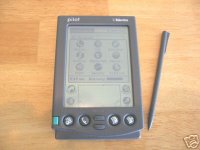
- Palm Pilot Personal 1997 - $12.11 -- a bit worn, bought with a Vx below -- less common, I believe than the 'Pro' model. 512K RAM, Palm OS 2.0, also available in German.
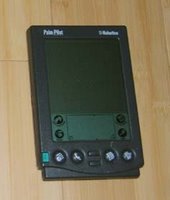
- Palm Pilot Professional 1997 - $25.51 -- brand new in box, a keeper -- For marketing, Palm partnered on this one with Franklin Day Planner -- 1MB RAM, 64K Heap, added backlight, available in French now, 1MB upgradable to 2MB .
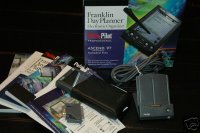
- Palm Pilot Professional 1997 - $20.50 -- excellent! (available for trading)
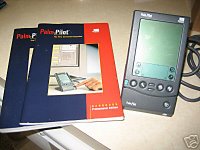
- Palm Pilot Professional 1997 - $6.00 -- slightly worn but works (also available).
- Palm III 1998 - $20.98 -- newish w/original box -- 2MB RAM, 96K Heap, OS 3.0, IR support, flashable ROM, 4 greyscales.
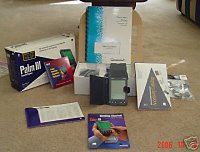
- Palm III 1998 - $4.26 -- problem: only boots partway (good for parts?)
- Palm IIIe 1999 - $17.49 -- w/some utilites -- Similar to Palm III, 2MB RAM, OS 3.3, not flashable ROM, high contrast 16 greyscales.

- Palm IIIe 1999 - $7.46 -- with a transparent case, worn, w/original box -- 2MB
- Palm IIIx 1999 - free -- in friend's box of surplus stuff, with some documentation, I paid $5 for a PalmPix camera like this one -- 4MB
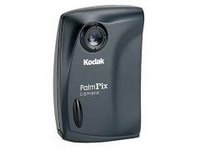
- Palm IIIxe -- $19.17 w/original box -- 8MB
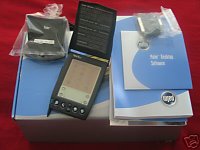
- Palm IIIc -- $36.83 included the following IIIc -- first? color screen in a PDA!

- Palm IIIc -- Japanese version -- $36.83, included with the other IIIc, w/Japanese CD, but the English version OS is installed.
- Rand McNally Streetfinder GPS for Palm III series -- $34.88 -- one of several GPS units available -- missing install CD, so I will use free software (better, so I've heard) -- I am also going to interface a SIRF II serial GPS (NMEA) to an LCD display from a cellphone.
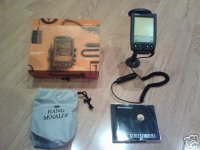
- Palm V -- $20.36 -- w/keyboard, original box and manual but no CD.

- Palm Vx -- ($12.11 included with a Palm Personal), 'V' is embossed on the front, but Vx printed on back see picture.

- Palm Vx -- $23.79 -- I thought this was a Palm V as labeled on front, but Vx label is on the back -- w/original box

- Palm Vx -- $27.00 Front embossed Vx (unlike the others), it does not hold a charge and the back is slightly damaged, no model # printed on back, included with the Epocrates (below)
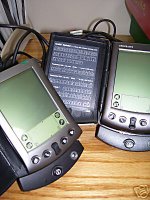
- Palm Vx Claudia Schiffer edition -- do not have -- pale metallic blue -- very rare, I saw one for auction and I should have bid, but I didn't realize what it was.
- Palm VII -- $10.50 -- wireless connectivity, uses standard cellphone frequencies (receives good signal near cell tower), but Palm.net was ahead of its time and is no longer available, so wireless function is useless now
- Palm VIIx -- $9.92 -- ditto re the wireless -- w/original box. Looks almost new.
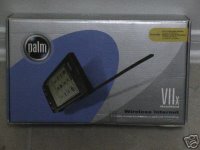
- Palm VIIx -- $9.00 -- I am loaning this to a friend who is just getting started with PDAs. He likes it and is now hooked, but will be searching for an expandable (flash card) model.
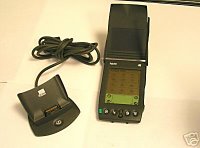
- Palm M100 -- $20.50 -- w/original box (no dock).

- Palm M100 Michael Jordan edition -- do not have -- differs primarily in a selection of prepackaged software apps -- not common, but not rare. here's a picture:
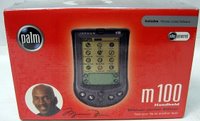
- Palm M105 -- $20.51 -- PDA cover flap broken, w/cool folding Palm branded keyboard and case (which appears new)

- Palm M125 -- $24.91 used, but w/original box, games CD
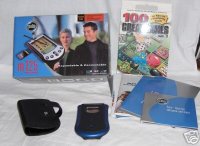
- Palm M130 -- $26.50 w/original box, small crack in shell near stylus -- an early color model
- Palm M500 -- $16.10 pda only --

- Palm M500 Michael Jordan edition -- do not have -- quite rare, only seen one on eBay.
- Palm M505 -- ~$47 -- another early color model. I purchased it 1-2 years ago for a never finished GPS project, but now I'll use one of my duplicates (the Vx loaner).
- Palm M515 -- do not have -- brighter than 505, and pricey due to color screen.
- Palm Zire Z21 (also known as M150) -- $10.36 -- Although the first of a new case design, this is the last of the Dragonball generation, newer ones have (much) higher speeds.

- Palm I705 -- $10.00 -- w/accessories, screen is scratched. Similar to VIIx internally, Zire Z21 externally.

- Palm Tungsten --do not have -- We are getting into later models, and if I were a truly "serious" collector I would be interested in these, but they are too expensive for me right now, so I will just sit back and watch (you can send me yours, though).PalmOS Models made or sold by other companies:
- Epocrates (rebranded Vx) -- $27.00 included with previous Vx -- Epocrates PDAs (there are several models, m500 ...) are set up with medical applications, but this one does not have them installed and I don't have the original CDs, its a darker bronze color than the regular Vx, I have also seen in dark blue. Epocrates models matching later Palm versions continue to be made and sold.
- IBM Workpad model 8602-10U (rebadged Palm Pilot) -- $4.99 -- IBM models have identical specs as their counterparts but are labeled IBM to be more acceptable to corporate purchasing departments, and are a different color, black .

- IBM Workpad 8602-20X (Palm III) -- 10.50 -- w/accessories
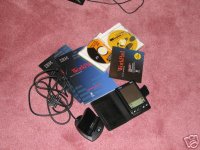
- IBM Workpad 30X (Palm IIIx) -- $31.34 -- new, sealed box. Wow!

- IBM Workpad c3 (Palm V/Vx) -- $14.00 -- works, but nearly dead battery, w/serial dock, case

- IBM Workpad c500 (Palm M500) -- $22.95 w/ no accessories, -- I won the auction, but oops -- it got lost in shipping, so my money was refunded. not rare.

- IBM Workpad c505 (Palm M505) -- do not have -- not rare.
- Symbol SPT 1500 (similar to Palm III) -- $28.06 -- Read barcodes with this. Yes, PalmOS models from Symbol have barcode readers -- SPT1500s are unusually expensive, typically about $100, even more for later models (SPT17xx, 18xx) which are just too cool looking.

- TRG rebranded Palm models (various) -- do not have -- more expandable than standard Palm, somewhat scarce so prices are substantially higher than for the similar Palm model. TRG became HandEra.
- Handera -- do not have -- succesor to TRG
- HandSpring Visor, Treo ... PalmOS but faster, has more advanced features -- I'm not collecting these at this time, not yet anyway.
- Sony Clie, and others... licensee of Palm OS. -- I'm not collecting these either.
- Kyocera (Qualcomm) QCP-6035 cellphone with PalmOS -- $19.59 -- with accessories, the Verizon CDMA cellphone technology is getting dated so these are cheap.
- Kyocera QCP-7135 cellphone with PalmOS -- do not have --
- Acer
- Legend
- Samsung
- Hunetec
- TapWave
- Aceeca
- GSL
- Garmin
- Qool
- Royal daVinci -- A Royal ripoff of the Palm software (they were subsequently sued and enjoined from selling them). I didn't/don't intend to collect any except the early Palms but I thought I should check out some competitors. I bid low and won a working unit for $6.00, but guess what? I wuz robbed -- it is vastly inferior to the Palm.

Summary
My collection contains mostly monochrome models (except a few, as noted) use a Motorola "Dragonball" CPU from 16 to 33 Mhz and are equipped with from 2 to 16 Mb of memory. All the early and III (except IIIc), V series and M100-125 use AAA batteries (Yay!) and the rest have internal rechargeable Li-OH batteries (Boo!). Mine are in various conditions from fairly fresh to probably dead. I have both new and used (mostly), some with original packaging, manuals, CDs, cases, etc. I have at least one recharger for each form-factor, but not one for every PDA, a few games and Palm branded or aftermarket accessories. I will have to come back here and document everything I have, and what is surplus, duplicates available for trade, or missing and needed. Trades anyone? Photos, descriptions, comments. Please... so much to do, so little time, sigh.
What's Next?
Now that I have most of the early basic common ones, I realize there too many models and variants to collect these on the cheap. After I acquire the common M500 and M515 I will pause and only bid on exceptional ones that I really need. Just by watching Ebay I am learning which PDAs are "rare" and desirable and will concentrate on getting those at a good price, as well as the best accessories. As with all collectibles, value comes from rarity, condition, and completeness. Did I mention condition? For collectors a pristine, unopened box (NIB, New in Box, or NOS, New Old Stock) with all the original contents is the holy grail. So I am surprised that you can still buy brand new, never opened, (occasionally even sealed) units for just a bit more than used, and for the serious collector, I would advise acquiring these NOW, while they are still around. But I've already sunk nearly $500 into this (wow) and I don't want to spend much more. Typically NIB units sell for double to triple the price of used, say $30-50, but if you consider "How long will these be available?", these prices might be viewed as pretty cheap in a few years). I'm almost over my initial cravings, so I may be on to a different addiction soon. I will likely use some of my duplicates for the Palm GPS and ... Recently I bought The Ultimate Palm Robot book which shows how to use old Palm PDAs as the brains of simple homemade robots.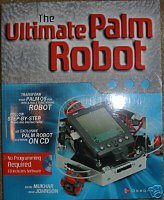

Labels: collections, palm pilot, pdas



